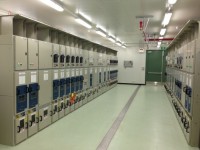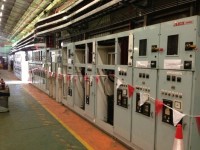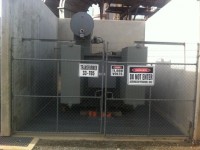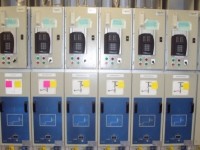Project Description
The key objectives of the project were to increase equipment reliability and reduce the likelihood of HV incidents by replacing two 40+ year old HV switchboards. The installation of remote switching to the new switchboards further reduced risk by removing the High Voltage (HV) operators away from potential ‘Line of Fire’ safety risks that prevailed whilst operating the old 3.3kV compressor substation switchgear.
The scope of the project was to construct/install a new portable 3.3kV substation to replace the existing 33-C1 and 33-C2 switchgear panels. In total, 19 drives required relocation from the old switchboards to the new substation, this included 16 DOL drives, two auto transformer starters and one multi stage resistance starter. The substation was pre-fabricated and elevated two metres to accommodate bottom entry cables. The substation was equipped with the following new equipment:
- Two 3.3kV switchgear panels to replace 33-C1 and 33-C2.
- Feeder, motor, bus zone and arc flash protection relays fully integrated into the switchgear panels.
- Trip and control battery chargers and battery systems.
- Remote switching panels for incomer and bus tie circuit breaker rack in/out and trip/close operation.
- Emerson UPS systems.
- Allen Bradley PLC networked into the site control system.
- Fire protection and gas suppression systems.
Two new 5MVA 11kV/3.3kV transformers and transformer compounds were installed to power one of the new switchboards, the other was powered by redirecting power from two existing 3MVA transformers as switchboards 33-C1 and 33-C2 were decommissioned.
Fields Contracting Engineers were engaged to complete the Execution Phase of the project. Detailed design of the 3.3kV switchgear panels had already been completed during the Define Phase study.
FCEng Scope
- Development of a detailed migration plan and schedule that allows drives to be migrated, transformers powered and commissioning completed with minimal disturbance to production.
- Management of shut-down planning to ensure minimal impact and downtime on operations and overlapping projects or other site maintenance works during commissioning.
- Development of detailed method statements and commissioning Inspection Test Plans (ITP’s) for each migration stage.
- Development of system checks and controls to allow the commissioning activities to proceed in a safe and orderly manner.
- Attend all HAZOP and other related project meetings as required.
- Manage the site “Technical Query” process and provide timely responses to engineering technical and other queries, ensuring there is a system in place and used for customer acceptance.
- Manage the Schneider (Areva) Factory Acceptance Testing (FAT) punchlist register until all items have been resolved.
- Engage the required technical resources when required.
- Complete detailed site “as building” review of project drawings to ensure there are no significant issues encountered during drive migration.
- Verify compliance on all electrical (and mechanical when appropriate) design drawings, specifications, operating and maintenance manuals produced by the vendors.
- Coordinate and manage site commissioning and site acceptance testing.
- Ensure all engineering work is performed to site standards and that all engineering and procurement activities are completed on schedule.
- Provide support during start-up whilst new plant or interfaces to old plant are subject to performance and acceptance testing.
- Ensuring Quality Assurance/Quality Control (QA/QC) standards are maintained during the construction and migration activities.
- Manage the complete project drawing set and ensure all changes are clearly marked on the drawings.
- Ensure the migration method statements are fully adhered to and all ITP’s are completed, documented and signed off.
- Provide technical detail to the client project manager on the progress and performance of the various project contractors.
Project Summary
The project was successfully completed with no recordable incidents and minimal impact on production. Site acceptance testing was completed prior to energisation of the new switchboards and transformers. Migration then progressed as per the migration plan and schedule for sixteen of the nineteen drives. The remaining three drives required a plant outage to migrate, which was completed at the earliest plant shut-down opportunity. The switchboard incomers and bus ties are now remotely racked in/out and the circuit breakers closed/tripped, removing the HV operator away from potential “line of fire” incidents.
- New 3.3kV Schneider switchgear
- Decommissioned switchgear
- New 11kV/3.3kV 5MVA transformer
- Part of new 3.3kV Schneider switchboard





Comments are closed.